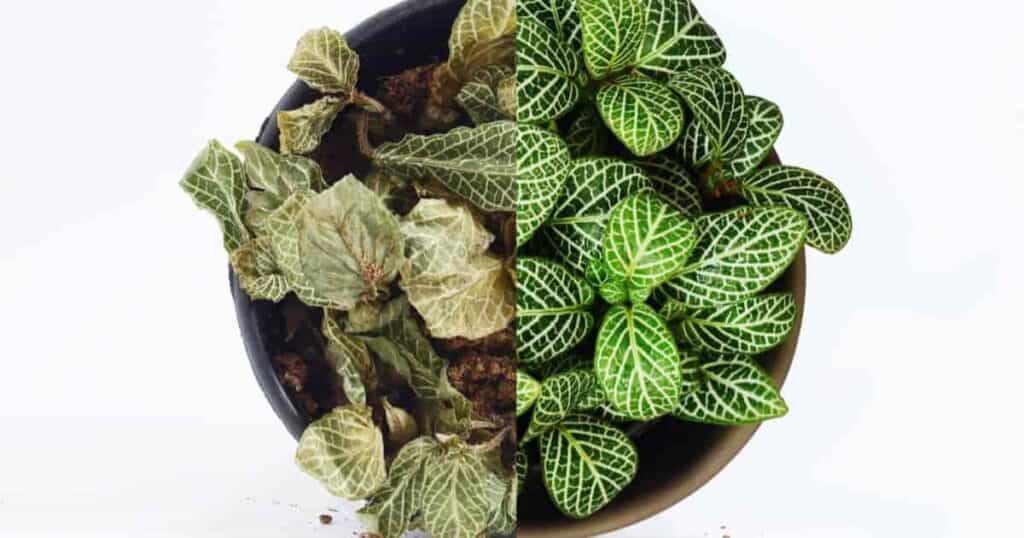[ad_1]
A popular myth in gardening circles claims that sugar water is a good plant fertilizer and can help plants recover from transplant shock. It’s easy to see why this notion would be popular. Most people already have a bag of sugar on hand; if you don’t, it’s cheap and easy to acquire.
Sadly, sugar water is not good for plants as a fertilizer or transplant shock tonic. In fact, using sugar water may block your plants’ roots and cause them to deflect water.
When a plant suffers from transplant shock, the problem is often caused by an inability to perform photosynthesis. Plants need the right amount of sun and water to complete this vital task, so using any substance that interferes with water uptake is not helpful.
Generally speaking, shelter from harsh elements, consistent care, bright indirect sunlight, and patience will help your plant recover from transplant shock.
Sugar Water & Plants Q&A
1. Why do some gardeners think sugar water is good for plants?
A misunderstanding of the mechanics of photosynthesis leads some gardeners to believe that plants can use table sugar. To conduct photosynthesis, plants need carbon dioxide, water, and energy to create starches and sugars.
A misunderstanding of this process has led some to believe that adding sugar will provide the plant with more carbohydrates that the roots can take up to boost the plant’s growth.
This is a flawed thesis because plants do not metabolize sugar through the digestive system as people do. Additionally, the sugar produced by plants is a complex monosaccharide chain structure that is difficult to break down. Table sugar is just simple glucose. Plants cannot use it.
When plants conduct photosynthesis, they create the amount of sugar necessary to survive and thrive at their particular stage of life.
For example, as a seed sprout grows into a seedling and then a young plant, it needs quite a bit of its own complex sugar. When it is mature, it will need less. The plant will regulate this on its own.
When you pour sugar water into a plant’s soil, the sugar just coats the plants’ roots and causes interference. Furthermore, sugar can spoil the soil and attract harmful soil fauna, leading to plant disease.
2. If a plant suffers from transplant shock, doesn’t it need extra sugar?
The same concepts apply to plants suffering from transplant shock as to any others. If your plant is experiencing shock because its roots are damaged or because it is simply adjusting to a new setting, pouring sugar water on the soil will only make matters worse.
On the other hand, gentle, consistent, correct care, plus patience, will lead to recovery from transplant shock.
3. Are there any correct uses for sugar water in the garden?
Yes, sugar can be used to preserve cut flowers and to feed beneficial pollinators.
Sugar is a preservative.
When you are gathering flowers from your cut flower garden, carry along a container of sugar water and put your cut flowers right into it.
Additionally, simple sugar can be absorbed by plant stems (as opposed to roots). So when you put cut flowers into sugar water, the blooms are tricked into “thinking” they are still on a living plant. This will extend the life of your bouquet.
When you arrange your cut flowers in a vase, fill the vase with a mixture of:
- 2 tablespoons of white vinegar
- 1 quart of warm water
- 3 tablespoons of sugar
Mix this up in advance so it will be cool when you are ready to use it. The sugar will continue to keep the blooms fresh, and the vinegar will help combat bacterial growth. Change the mixture every couple of days, and rinse the plant stems for the best results.
Attract and nourish beneficial garden fauna.
Sugar water is also useful in the garden as a pollinator attractant. Specifically, keeping feeders filled with sugar water hanging from your trees, bushes, and porch eaves will attract hummingbirds.
According to the Audubon Society, the best mix for hummingbirds consists of the following:
- 1 part plain table sugar
- 4 parts boiling water
Use a clean spoon to stir the sugar and water in a clean container. Allow it to cool thoroughly, and fill your feeders. No artificial color is necessary.
Be sure to refill your hummingbird feeders every couple of days. Clean them thoroughly each time you refill them.
Other pollinators, such as bees, wasps, ladybugs, and more, may be attracted to your sugar water, and it won’t hurt anything if they partake.
Include plants that attract pollinators and beneficial insects to have a healthy and diverse population of them in your garden.
4. How can I keep my plants from having transplant shock?
Think about how plants usually live. They don’t move around much!
- When you need to bring a plant home from the nursery or even a friend’s garden, make it a short, direct trip. Avoid leaving your plant in a cold or hot car. If you must carry a large plant, shrub, or tree in an open truck bed, lay it down and cover it with a tarp to prevent wind damage.
- When transplanting garden plants from one location to another or potted plants from one container to another, begin with a good watering. Keeping the root ball moist throughout the procedure will help you avoid damaging the roots.
- If you need to dig a plant up, make a large enough circle around the plant to keep a great deal of the roots. Take care to keep the root ball intact. Don’t knock off excess soil. It will protect the roots.
When you replant, handle the root ball gently. Don’t massage the roots.
- Once the transplant is complete, finish up with another thorough watering. Keeping your plant hydrated through this stressful event helps ensure against transplant shock.
5. What if a plant has all the symptoms of transplant shock but has not been transplanted?
Understand that transplant shock can occur without transplanting! For example, some houseplants will experience transplant shock just from moving around. Avoiding unnecessary movement can help prevent this.
When you obtain a new potted plant, have a spot picked out for it before you arrive home. Then, put it there, and don’t move it around or actually transplant it for a couple of weeks.
This can be its quarantine time. It will allow the plant to adjust to its new surroundings as you assure yourself you are not bringing in any pests, bacteria, or fungi.
6. How do you help a plant heal from transplant shock?
Plants experiencing transplant shock need peace, quiet, and consistency. So give your new transplant shelter, consistent warmth, bright, indirect sunlight, and consistent watering to help it get established.
If you wish, you can provide a half dose of high-nitrogen fertilizer to help it grow new leaves.
If the plants’ existing leaves wilt, prune them away. If the plant is gangly, trim away excess stems and limbs. This will allow the plant to put energy into establishing good root growth.
Be patient and consider the season. It can take days, weeks, or even months for a plant to recover from transplant shock fully. This is especially true if you move or transplant outside the plants‘ typical growing season.
For example, a plant moved or transplanted in autumn may seem to dwindle only to spring into life when the weather warms up.
[ad_2]
Source link










 + Planting String of Watermelon Succulents
+ Planting String of Watermelon Succulents  with Garden Answer
with Garden Answer


